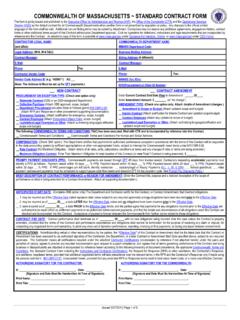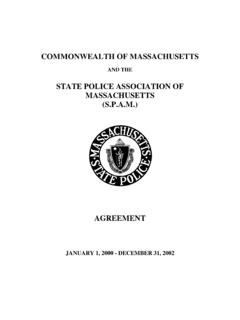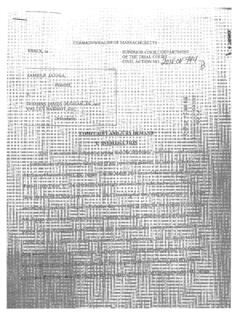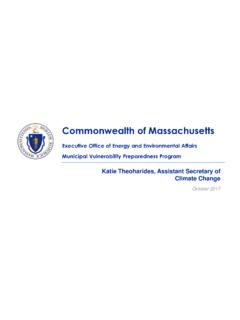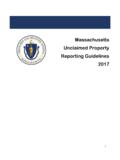Transcription of Commonwealth of Massachusetts
1 Commonwealth of Massachusetts Executive Office of Energy and Environmental Affairs and Department of Environmental Protection Technical Support Document on Proposed Regulatory Amendments to: 310 CMR Reducing CO2 Emissions from Electricity Generating Facilities October 13, 2017 Regulatory Authority: c. 21A, 2, 8, and 16 c. 21N, 2(a)(5), 3(b)-(d), 4, and 7 and c. 111, 2C and 142A 142E 2 Contents I. INTRODUCTION .. 2 II. BACKGROUND AND PURPOSE .. 2 III.
2 DESCRIPTION OF THE PROPOSED AMENDMENTS .. 3 IV. ECONOMIC IMPACTS .. 4 V. SMALL BUSINESS IMPACT STATEMENT .. 4 VI. AGRICULTURAL IMPACTS .. 4 VII. IMPACT ON Massachusetts MUNICIPALITIES .. 4 VIII. Massachusetts ENVIRONMENTAL POLICY ACT (MEPA) .. 4 IX. IMPACTS ON OTHER PROGRAMS AIR 4 X. PUBLIC PARTICIPATION .. 4 I. INTRODUCTION The Massachusetts Executive Office of Environmental Affairs (EEA) and the Massachusetts Department of Environmental Protection (MassDEP) are proposing to amend 310 CMR : Reducing CO2 Emissions from Electricity Generating Facilities.
3 The amendments are minor technical corrections that affect two (2) of the twenty one (21) existing facilities subject to the regulation. Instructions for commenting on this proposed regulation are provided at the end of this technical support document (TSD). II. BACKGROUND AND PURPOSE In August 2017, EEA and MassDEP finalized 310 CMR , which creates an allowance trading program that requires large power plants in Massachusetts to comply with an annually declining limit on carbon dioxide (CO2) EEA and MassDEP are proposing to amend 310 CMR because, due to an oversight, errors that were identified by commenters during the public comment process were not addressed in the final regulation.
4 Specifically, the following incorrect electricity generation data for two facilities was used to calculate individual facility CO2 emission limits for 2018: For the Fore River Energy Center power plant: o 2013: 3,818,127 MWh (should have been 3,830,556 MWh) o 2014: 3,576,401 MWh (should have been 3,968,808 MWh) o 2015: 2,315,369 MWh (should have been 3,801,336 MWh) 1 Additional information about 310 CMR is available at Posted documents include Appendix B of the response to comments document, which includes the calculation discussed in this TSD.
5 3 For the Millennium Power Partners power plant: o 2015: 1,867,107 MWh (should have been 2,095,394 MWh) The limits that were determined using this data were used to calculate allowance allocations for 2018. Because allowance trading is allowed, the regulation does not directly limit individual facilities emissions; however, the allowances do have financial value for facilities. Therefore, it is necessary and appropriate to correct these errors as soon as possible so the facilities have certainty before the start of the program on their 2018 CO2 allowance allocations.
6 The amendments accomplish this in a way that avoids impacts to other regulatory requirements, such as other facilities 2018 allocations or emissions in any year other than 2018. III. DESCRIPTION OF THE PROPOSED AMENDMENTS A spreadsheet showing how facilities emissions limits were calculated from electricity generation data was published as Appendix B of the response to comments document that was published with the final regulation in August, 2017. Replacing the data with the corrected data in that spreadsheet yields the following corrected 2018 emissions limits for the two facilities (in millions of metric tons of carbon dioxide): Fore River Energy Center: 1,433,568 tons (was finalized as 1,243,593 tons) Millennium Power Partners: 667,082 tons (was finalized as 662,129 tons) The proposed amendments to the regulation will correct these two facilities emission limits.
7 In order to make these corrections without unfairly reducing other facilities limits, it is also necessary to increase the 2018 total aggregate emissions limit (total allowable emissions across all regulated facilities) to 9,149,979 tons (was finalized as 8,955,051 tons). This increase in the 2018 limit is appropriate because: The 2020 emissions limit is unchanged; therefore, EEA s and MassDEP s analysis of the contribution of 310 CMR limits, along with other regulations and policies, to meet the statewide greenhouse gas emissions reductions goal of 25 % by 2020 is unaffected.
8 The amended 2018 aggregate limit is only higher than the 2018 limit that was finalized in August 2017, and is less than 1% different than the 2018 limit that was proposed in December 2017. This small percentage change in the 2018 limit will not affect the ability of regulated electricity generating facilities to meet the 2020 limit. The amendments do not affect any year other than 2018. This is possible because 2018 is the only year for which the regulation includes individual facility limits ( , allowance allocations) that must equal the aggregate limit.
9 (Auctions will be used to allocate allowances in all later years.) Of note, this is consistent with the approach taken in 2004 when amendments to 310 CMR were made to increase some of the facilities annual NOx allocations due to an error in the final regulation. Because the regulation also specifies the existing facility aggregate limit for 2018 (total allowable emissions across all of the 21 existing facilities), that value is also being changed by the same amount as the total aggregate limit. 4 IV.
10 ECONOMIC IMPACTS The amendments are technical corrections that will have minimal economic impacts. V. SMALL BUSINESS IMPACT STATEMENT The amendments are technical corrections that will not have any negative impact on small businesses. VI. AGRICULTURAL IMPACTS The amendments are technical corrections that will not have any negative impacts on agricultural production. VII. IMPACT ON Massachusetts MUNICIPALITIES The amendments are technical corrections that will not negatively affect cities or towns. VIII.



